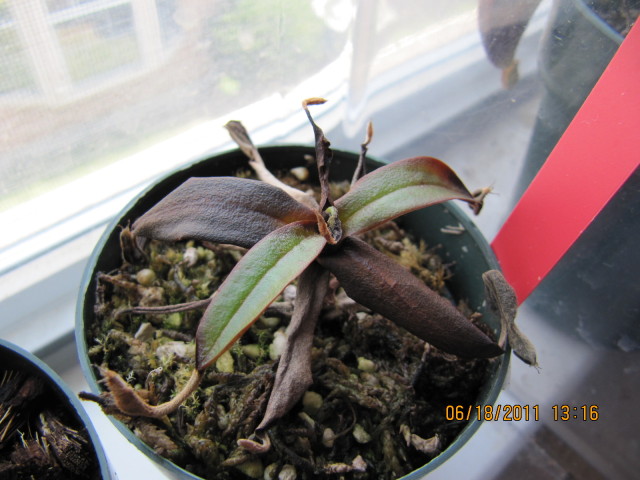Question
 Dying Mikei
Dying Mikei
Hi Sarracenia Northwest,
I bought a N. mikei back in January, and it was doing just fine until recently. The leaves started to turn black, and eventually, so did the growing point of the plant. Actually, I've noticed that this has happened with a lot of my plants, all of which are highlanders.
I live in the Dallas area of Texas, where it is usually 78 degrees in the house during the summer, and 65-68 degrees in the winter. The plants grow in an east-facing window, where they get about 3-4 hours of sunlight in the morning, and indirect light for the rest of the day. They grow in small, open-topped, plastic terrariums. They are also watered using distilled water from walmart, and misted every morning.
The N. Mikei is growing alongside a N. Lowii x Campanulata, which I purchased with the Mikei, but it's growing phenomenally, already putting out 4 new pitchers since I got it. However, the N. boschiana x densiflora, which I got during the January of last year, is a very pale yellow-green color, with only 3 leaves growing at a time.
Because N. Mikei is a highland plant, is the blackness caused by the lack of drop in temperature at night? In the past, I used to put my highlanders in a cooler with a couple of ice packs to try and cool them down at night, but those still died of the same cause. I am really puzzled at the cause of death in my plants.
Thanks!
Steven
AnswerThank you for uploading a clear photo of your plant. This helps me out a lot. Yes, something is definitely amiss with the plant. Based on what I see in the photo, I strongly suspect poor root health. The most common causes are bacteria, fungus and parasites.
Regardless of the cause, unpot the plant and examine the roots. If you see tiny bugs or tiny worms running through the media, you got parasites eating the roots. The only way to salvage the plant is to spray the roots with a suitable insecticide. Also repot the plant in fresh media. As a precaution, you should also spray the soil of the other plants nearby.
If you don't see bugs, smell the media. If it smells funky, it may be bacteria or fungus. In this case, spray the roots with a sulfur fungicide and repot into fresh media. The fungicide won't kill the bacteria, but changing the media with fix the problem.
In either case, repotting is highly recommended at this point. While it may seem counter intuitive not to repot because of the plants poor health, keep in mind that keeping the plant in the same media may do more harm than good. Once properly treated, the plant will take another 3 months to recover.
Other than changing the soil, your other factors seem appropriate. The only thing I might recommend is making sure the top of the soil dries slightly before top watering again.
Good growing!
Jacob Farin






